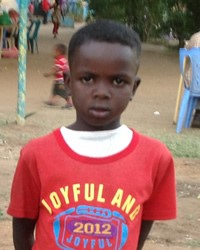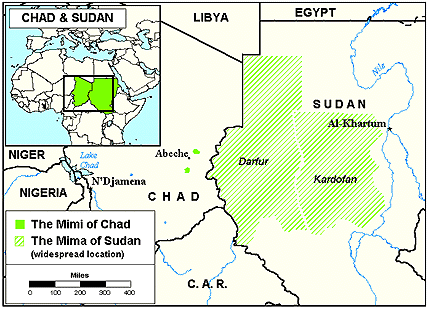Amdang Mimi people originated in the Nile Valley of Egypt with a westward migration taking place in the fifteenth and sixteenth centuries. Some settled in the Biltine region of Chad where they became farmers. Others became nomadic herdsmen and maintained frequent contact with the Arab nomads. The settled Biltine group, or Mimi, still speak their ancestral language, Amdang. The nomadic Amdang eventually adopted the Arabic language as their mother tongue.
Amdang in Sudan are mostly settled farmers who inhabit the hilly eastern part of Dar ("home of") Mimi (Amdang). There they raise grains, beans, sesame, and a variety of other crops; they also keep some livestock. Few Amdang are nomadic herdsmen. They live like pastoral Arabs, rather than farming for their livelihood. Amdang nomads live in thatched-roof mud homes. Agan is the largest urban area for the Amdang. Dar Mimi is sandy and virtually treeless. Because of the shortage of water in the area, the settled Amdang people are limited because of the number of animals they can keep. For this reason, they tend to force nomadic Amdang to people to migrate southward and westward.
They are surrounded by a number of other ethnic groups, including the Mahamid Arabs, the Zaghawa, the Mararit, the Tama, and various Maba-speaking tribes. Settled Amdang people sometimes intermarry with Maba and Arabs; whereas, nomadic Amdang intermarry with Zaghawa and the Abu Sharib peoples. An Amdang person will never marry a Tama person. Because of this intermarriage among Amdang and neighboring groups, cultivation techniques and vocabulary have been assimilated into Amdang culture. Social and political lives of Amdang people have been disrupted due to civil wars in Chad in recent years. The Amdang of Sudan are chiefly nomadic herdsmen. Most of them own herds of camels and flocks of sheep and goats. During winter months, young men take camels to grazing areas abundant in water and grass. Women weave rugs while men make water-skins, buckets, and ropes. Children have responsibilities such as spinning goat and camel hair into thread. Men also go to market towns to sell animals or to buy grain, cloth, sugar and tea. These market centers include Wada'ah, Fafa and Magrur merchants.
The Amdang are entirely Muslim, as are many other groups in the Sudanic region of Africa because of the influence of Arab merchants. Islam is a religion of works based on five basic teachings or "pillars." Muslims must affirm that "there is no god but Allah, and Mohammed is his prophet." They are also required to pray five times a day, give alms to the poor, fast during the month of Ramadan, and try to make at least one pilgrimage to Mecca. Amdang people are not as strict in their observance of Islam as are some other Muslim groups in the area; however, they follow most of the rules.
Unfortunately, Amdang people have never been exposed to the gospel. There are no Christian resources available to them. The Scriptures need to be made available in their languages and Christian broadcasts need to be aired in their regions so that they will hear the message of salvation. The literacy rate in both countries is low. These people need more educational opportunities and quality health care facilities. Perhaps Christian teachers and medical workers will have the greatest opportunities to share the love of Jesus with them.
Pray that God will call Christian teachers and medical workers to minister to Amdang people of Sudan.
Ask God to raise up prayer teams who will begin breaking up the spiritual soil of Chad and Sudan through intercession, evangelism, church planting and discipleship.
Pray for Amdang family leaders to have dreams and visions of the risen Christ, leading them to open their communities to him.
Scripture Prayers for the Mimi, Amdang in Sudan.
| Profile Source: Joshua Project |











